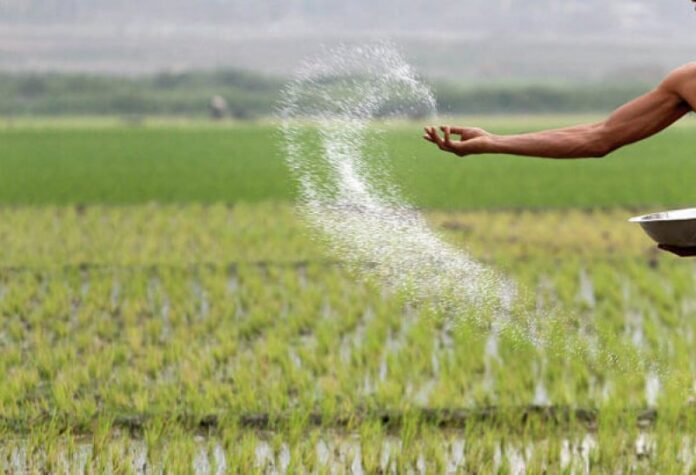The government of Pakistan has once again found itself at odds with the fertilizer industry over a lack of measures taken by them in the federal budget to settle payments for outstanding subsidies and fixing the sales tax imbalance issue.
A meeting between senior fertilizer executives and finance minister Miftah Ismail failed to reach any clear way forward on settling the longstanding issue of the outstanding subsidy and sales tax.
The key issues discussed in the meeting were the difference between the input and output sales tax, the price of feed gas, and the smuggling of urea which has kept prices stagnant.
The government currently owes the industry nearly Rs 80 billion in paybacks, with subsidy receivables for 2016-18 amounting to Rs 19.2 billion yet to be paid, while sales tax worth Rs 60 billion also remains unpaid and is mounting – according to sources high up in the fertilizer industry.
It is an amount they have been trying to recover for a couple of years now, and the Fertilizer Manufacturers of Pakistan Advisory Council (FMPAC) had protested last year as well, saying the stuck tax refunds had caused cash flow challenges for the manufacturers.
Sales tax issue
The fertilizer industry faces a key problem because of the disparity between the output sales tax and the input sales tax. Currently, they are paying more input sales tax than output sales tax, an issue that they have gone back-and-forth on with the government before, including after last year’s budget.
To understand this, a little background of how taxation works is necessary. Generally, any product goes through two phases of taxation – input sales tax and output sales tax.
Input sales tax is the tax that any manufacturer pays on imports or any other inputs and is usually paid directly to the government. The output sales taxes are what you would charge customers while selling your final product – and is also how manufacturers recover some of their original paid tax.
For example, if a registered person purchases goods for Rs.100 and pays Rs.15 as sales tax (input tax)@ 15% his total purchase price becomes Rs 115. If he/she sells the goods for Rs 200 and charges Rs 30 @ 15%(as output tax) his total sale price becomes Rs 230.
Normally this would mean the input tax, in this case Rs 15, will be subtracted from the output tax, in this case Rs 30, and the final payable tax will be Rs 15. However, as one senior executive at a fertilizer company explained to Profit, in the case of the fertilizer industry, the output sales tax is 2% whereas input sales tax is maintained at 5-17%.
Because of this, the fertilizer industry actually ends up paying more tax to the government than they collect, and the government is then supposed to pay them back for this. Currently, this mismatch is leading to a GST refund of PKR 62 to 175 per bag. However, because of the prevalent fiscal account situation the government is sluggish in returning this money which causes a cash flow headache for the industry.
Sources have said that the government, to stop further bleeding of the industry on the sales tax front, may make urea sales tax exempt. This would mean no output sales tax and input sales tax to become part of the cost. This will lead to increase in cost and resultant per bag price of urea in the range of PKR 62-175 depending upon the situation of each industry player.
Gas supply and smuggling
Another issue that is facing the industry is inconsistent gas supply. One of the goals here may be to bring the price of feed gas for urea manufacturers in line with industry gas price, which will lead to urea prices increasing further.
Currently, Engro Fertilizers has shared that it is the only company receiving gas under the Petroleum Policy 2012. This means they are receiving gas at the highest rate of US$ 5.3622 (PKR 1,100 +) per mmBTU. RLNG based players also shared that the high price of feed of PKR 830 per mmBTU is also impacting their profitability significantly.
Other fertilizer companies receive feed gas at ~PKR 300 per mmBTU. Higher prices of feed gas coupled with rising sales tax receivable is leading to significant cost pressure, that is making PP and RLNG based plants unsustainable.
Industry leaders have claimed that if additional and consistent gas is provided, the industry may even export the surplus of urea production capacity over domestic demand. However, this ambition is also undercut by the problem of smuggling.
The industry claims that despite reduction of urea prices by manufacturers, urea prices have remained the same primarily due to smuggling of urea due to heavy subsidies. Some headway has been made on this front, with the government and fertilizer executives agreeing that they would work together to come up with a coupon based mechanism whereby prices of urea would be increased in line with the gas cost, and specific direct subsidy for small farmers may be provided through coupon scheme to ensure that subsidy for domestic farmers remains within the country.




